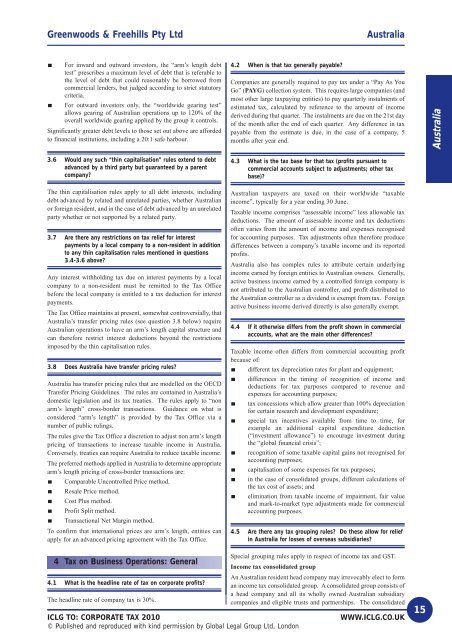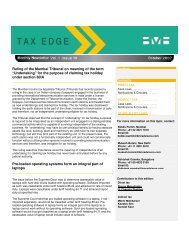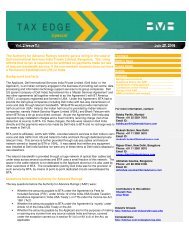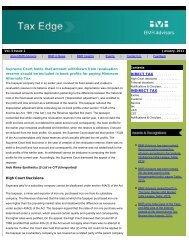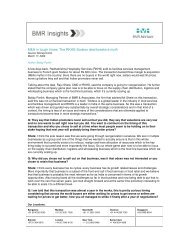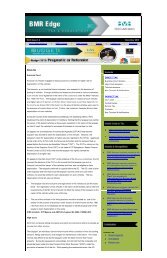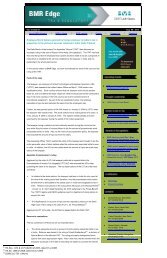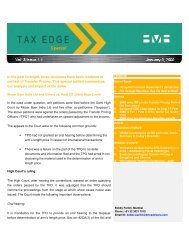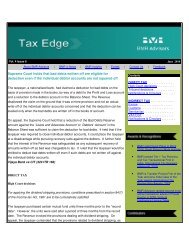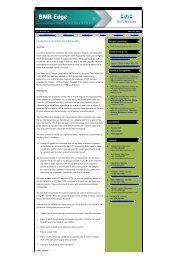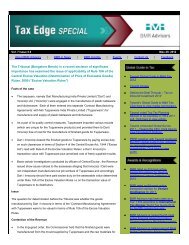Corporate Tax 2010 - BMR Advisors
Corporate Tax 2010 - BMR Advisors
Corporate Tax 2010 - BMR Advisors
Create successful ePaper yourself
Turn your PDF publications into a flip-book with our unique Google optimized e-Paper software.
Greenwoods & Freehills Pty Ltd<br />
Australia<br />
For inward and outward investors, the “arm’s length debt<br />
test” prescribes a maximum level of debt that is referable to<br />
the level of debt that could reasonably be borrowed from<br />
commercial lenders, but judged according to strict statutory<br />
criteria.<br />
For outward investors only, the “worldwide gearing test”<br />
allows gearing of Australian operations up to 120% of the<br />
overall worldwide gearing applied by the group it controls.<br />
Significantly greater debt levels to those set out above are afforded<br />
to financial institutions, including a 20:1 safe harbour.<br />
4.2 When is that tax generally payable<br />
Companies are generally required to pay tax under a “Pay As You<br />
Go” (PAYG) collection system. This requires large companies (and<br />
most other large taxpaying entities) to pay quarterly instalments of<br />
estimated tax, calculated by reference to the amount of income<br />
derived during that quarter. The instalments are due on the 21st day<br />
of the month after the end of each quarter. Any difference in tax<br />
payable from the estimate is due, in the case of a company, 5<br />
months after year end.<br />
Australia<br />
3.6 Would any such “thin capitalisation” rules extend to debt<br />
advanced by a third party but guaranteed by a parent<br />
company<br />
The thin capitalisation rules apply to all debt interests, including<br />
debt advanced by related and unrelated parties, whether Australian<br />
or foreign resident, and in the case of debt advanced by an unrelated<br />
party whether or not supported by a related party.<br />
3.7 Are there any restrictions on tax relief for interest<br />
payments by a local company to a non-resident in addition<br />
to any thin capitalisation rules mentioned in questions<br />
3.4-3.6 above<br />
Any interest withholding tax due on interest payments by a local<br />
company to a non-resident must be remitted to the <strong>Tax</strong> Office<br />
before the local company is entitled to a tax deduction for interest<br />
payments.<br />
The <strong>Tax</strong> Office maintains at present, somewhat controversially, that<br />
Australia’s transfer pricing rules (see question 3.8 below) require<br />
Australian operations to have an arm’s length capital structure and<br />
can therefore restrict interest deductions beyond the restrictions<br />
imposed by the thin capitalisation rules.<br />
3.8 Does Australia have transfer pricing rules<br />
Australia has transfer pricing rules that are modelled on the OECD<br />
Transfer Pricing Guidelines. The rules are contained in Australia’s<br />
domestic legislation and its tax treaties. The rules apply to “non<br />
arm’s length” cross-border transactions. Guidance on what is<br />
considered “arm’s length” is provided by the <strong>Tax</strong> Office via a<br />
number of public rulings.<br />
The rules give the <strong>Tax</strong> Office a discretion to adjust non arm’s length<br />
pricing of transactions to increase taxable income in Australia.<br />
Conversely, treaties can require Australia to reduce taxable income.<br />
The preferred methods applied in Australia to determine appropriate<br />
arm’s length pricing of cross-border transactions are:<br />
Comparable Uncontrolled Price method.<br />
Resale Price method.<br />
Cost Plus method.<br />
Profit Split method.<br />
Transactional Net Margin method.<br />
To confirm that international prices are arm’s length, entities can<br />
apply for an advanced pricing agreement with the <strong>Tax</strong> Office.<br />
4.3 What is the tax base for that tax (profits pursuant to<br />
commercial accounts subject to adjustments; other tax<br />
base)<br />
Australian taxpayers are taxed on their worldwide “taxable<br />
income”, typically for a year ending 30 June.<br />
<strong>Tax</strong>able income comprises “assessable income” less allowable tax<br />
deductions. The amount of assessable income and tax deductions<br />
often varies from the amount of income and expenses recognised<br />
for accounting purposes. <strong>Tax</strong> adjustments often therefore produce<br />
differences between a company’s taxable income and its reported<br />
profits.<br />
Australia also has complex rules to attribute certain underlying<br />
income earned by foreign entities to Australian owners. Generally,<br />
active business income earned by a controlled foreign company is<br />
not attributed to the Australian controller, and profit distributed to<br />
the Australian controller as a dividend is exempt from tax. Foreign<br />
active business income derived directly is also generally exempt.<br />
4.4 If it otherwise differs from the profit shown in commercial<br />
accounts, what are the main other differences<br />
<strong>Tax</strong>able income often differs from commercial accounting profit<br />
because of:<br />
different tax depreciation rates for plant and equipment;<br />
differences in the timing of recognition of income and<br />
deductions for tax purposes compared to revenue and<br />
expenses for accounting purposes;<br />
tax concessions which allow greater than 100% depreciation<br />
for certain research and development expenditure;<br />
special tax incentives available from time to time, for<br />
example an additional capital expenditure deduction<br />
(“investment allowance”) to encourage investment during<br />
the “global financial crisis”;<br />
recognition of some taxable capital gains not recognised for<br />
accounting purposes;<br />
capitalisation of some expenses for tax purposes;<br />
in the case of consolidated groups, different calculations of<br />
the tax cost of assets; and<br />
elimination from taxable income of impairment, fair value<br />
and mark-to-market type adjustments made for commercial<br />
accounting purposes.<br />
4.5 Are there any tax grouping rules Do these allow for relief<br />
in Australia for losses of overseas subsidiaries<br />
4 <strong>Tax</strong> on Business Operations: General<br />
Special grouping rules apply in respect of income tax and GST.<br />
Income tax consolidated group<br />
An Australian resident head company may irrevocably elect to form<br />
4.1 What is the headline rate of tax on corporate profits<br />
an income tax consolidated group. A consolidated group consists of<br />
a head company and all its wholly owned Australian subsidiary<br />
The headline rate of company tax is 30%.<br />
companies and eligible trusts and partnerships. The consolidated<br />
ICLG TO: CORPORATE TAX <strong>2010</strong><br />
WWW.ICLG.CO.UK 15<br />
© Published and reproduced with kind permission by Global Legal Group Ltd, London


